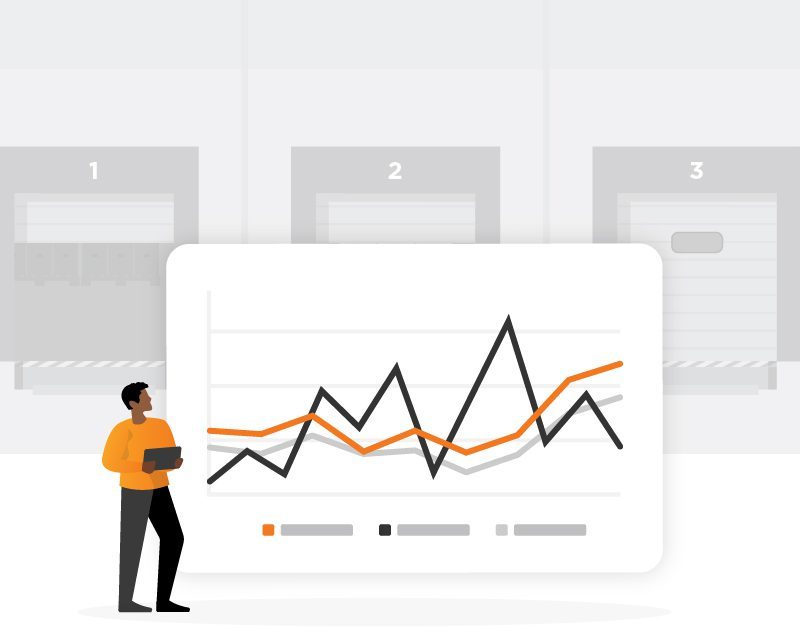Not a single business ignores its supply chain as a competitive advantage. Improving your warehouse management metrics should take center stage in your growth strategy because the fulfillment experience will be the only thing customers see.
Warehouse management metrics matter
The role of a warehouse has always been integral to the supply chain, but with modern advancements, you can do so much more.
- How well are your warehouses performing?
- Can you assess metrics promptly, as often as you want?
- Do you know what key performance indicators (KPIs) have the most impact?
By understanding, setting, and tracking the right warehouse management metrics, you can gain valuable insights into your work processes and improve them. Throughput, error rates, processing cost per unit, and labor efficiency are some of the top warehouse management metrics that will grow or slow a company.
Types of warehouse metrics
Warehouse management metrics typically fall into one of these top 4 categories, which I’ll outline in a second:
- Warehouse Management
- Inventory Management
- Order Management
- Supply Chain Management
A warehouse management system (WMS) uses KPIs to streamline the processes and tasks that keep a warehouse running efficiently. It standardizes and monitors your warehouse to reveal bottlenecks, performance gaps, and inaccurate data. The right WMS ensures that space, resources, labor, and time are all used optimally.
Storage Utilization
This metric evaluates space usage within the warehouse. Well-organized and efficient storage allows higher volumes of stock while reducing confusion, clutter, and fulfillment times.
Monitoring storage utilization over time drives peak season forecasting and will highlight the amount and timing of third-party warehousing needs.
Best-in-class operations, on average according to WERC’s DC Measures 2022 report, utilize more than 95% of available warehouse capacity and 100% during peak season periods.
Learn how Lazy One improved storage utilization with Deposco
Labor Productivity
Managing personnel is an essential warehouse task. Informed labor management leads to better control of order fulfillment processes and reveals blockages or gaps in the pick-pack-ship process.
Detailed systems will allow for these numbers to be sliced by individuals and teams as well as the job function and area in which they were performing tasks. Over time, this creates engineering standards and reporting on performance to the mean.
Best-in-class warehouse metrics for labor productivity include:
- Lines received and put away per hour: >68.9
- Lines picked and shipped per person hour: >89.6
- Orders picked and shipped per person hour: >48
Learn the top supply chain tech tackling ongoing labor challenges.
Watch how National Ropers Supply decreased labor hours by 40% weekly with Deposco.
Facility Throughput
Facilities are designed with a certain amount of inbound and outbound capacity. Tracking the inbound is important for proper staffing by the expected receipt date and can be used as input for PO cadences.
Similarly, the number of outbound trucks – Retail, B2B, and Ecommerce – should be closely monitored so as not to exceed dock-door constraints. Forecasting Inbound and Outbound consistently over either value should trigger planning for expansion or a new building.
Learn 5 supply chain technologies to do more with less in your warehouse.
Read how ITB shipped 9X more packages in its first year on Deposco.
Carrying Costs
Less prominent but no less important, tracking carrying costs will improve your overall profitability by mitigating waste and inefficiencies in your warehouse. This is a direct input to calculating the net operating margin.
Best-in-class operations typically track the following cash-to-cash metrics:
- Inventory Days of Supply: <23.6
- Average Days of Payable: <25.6
- Average Days of Sales Outstanding: <10
Over time, tracking carrying costs creates a benchmark for period-over-period analyses. Drilling down into costs can decipher whether you’re experiencing a natural trend or an improvement opportunity. Look at all of these inputs in aggregate to lower your carrying costs:
- Fixed Costs
- Variable Costs
- Packing Materials
- MRO
- Labor
- Utilities
Learn more about Deposco’s Warehouse Management Software.
Discover how our WMS platform helped EDC reduce total fulfillment costs by 77%.
Inventory management KPIs
When one says the word warehouse, the first thing many think of is inventory management. A core component of warehouse management, the handling of inventory (receiving, storage, and picking) plays into every other aspect of inventory fulfillment. After all, no order is complete without the desired product!
Solid inventory management system KPIs help you understand how to effectively stock, track, and ship inventory – which streamlines fulfillment and returns and improves customer satisfaction.
Inventory Turnover
Measuring how frequently products are sold and restocked helps warehouses stay ahead of demand. This inventory management metric assists with sales issues such as over- or understocking products.
The ideal inventory turnover ratio for most industries will be between 5 and 10, meaning the company will sell and restock inventory roughly every 1-2 months. This will be higher for industries with a short shelf life, such as perishable foods.
Learn the benefits of an inventory management system.
See how Hourglass Cosmetics grew YOY shipments 6.5X with Deposco.
Return Rate
Returned products can provide a lot of data depending on when and why the return took place. High return rates could mean a serious flaw with the product.
On average, ecommerce sales see an 18.1% return rate, while physical stores experience returns of only 8-10%.
Backorder Rate
Poor inventory management can lead to stockouts, which create backorders. As such, measuring backorders provides insight into potential problems with certain products. Your backorder rate can help anticipate and prevent stockouts before they happen.
The best-in-class metric for backorders is <1% as a percentage of total lines.
Learn omnichannel order fulfillment strategies to eliminate backorders.
Watch how Restorix Health | AMT achieved 20% fewer stockouts with Deposco.
Aging and Obsolete Inventory
Based on product catalog choices and returns, warehouses will have a portion of their storage dedicated to unsellable inventory in one status or another. This is an important inventory management metric for operations.
In some instances, this is a work queue that should be worked around orders. In others, it’s inventory waiting to be returned to the vendor or destroyed. An acceptable level should be set and not exceeded; otherwise, it can be a drag on the primary job of your pickers and packers. In addition, there might be more sustainable logistics practices to handle the return journey of a product.
Fast delivery is no longer all that matters; learn about the environmental cost of returns.
Available-to-Promise (ATP)
Beyond simply stocked inventory, looking at the combination of uncommitted inventory and expected replenishment orders within SLA allows for products to be made available for sale faster.
When highly accurate, the ATP inventory management metric has a direct, positive effect on Inventory Turnover and service levels.
Here are some of the common warehouse metrics related to service levels:
- Percent of Orders with On-Time Delivery: best-in-class – >98.8%
- Shipped Complete per Customer Order: >99.6%
- Shipped Damage Free (Outbound): >99.6%
- Correct Documentation (ASN, Invoice, etc.): >99.64%
Learn how order management systems can improve your ATP levels.
Watch how Feature reduced overselling and chargebacks to grow SKUs by +78%.
Cycle Count Accuracy (CCA)
Order systems are 100% reliant on accurate information. If the quantity in the WMS system is not as accurate as possible, this directly impacts the customer’s ability to place an order with confidence.
The industry benchmark for CCA is 95% or higher, but you can set your target based on your business needs and expectations.
Regularly checking random SKUs in the warehouse gives a picture of overall inventory accuracy. Consistently falling below acceptable thresholds should trigger process reviews, training verification, or the next topic.
Inventory management metrics within Deposco can automate the process of cycle counts, significantly boosting productivity while delivering near-perfect inventory accuracy.
Learn how Power Design Resources used cycle counting to increase order accuracy to 99.7% and quadruple order volume!
Shrinkage / Inventory Swell
Missing stock is as important as excess inventory when managing the warehouse. Standard scenarios like mis-scanning the Location Barcode will occur, leading to inaccuracies that have to be researched. In extreme situations, consistent patterns of shrinkage should trigger Loss Prevention cases.
According to best-in-class standards, you should aim to keep shrinkage below 1% or 2%.
Learn how Deposco’s Inventory Management Software helps track and improve your inventory management metrics.
Order management KPIs
If inventory management is the what, then order management is the how of fulfillment.
Timeliness, accuracy, and housing are all major considerations when determining the most efficient order fulfillment process. Many factors affecting OMS management exist outside of the warehouse with limited control possible.
As such, order management should be meticulous and deliberate to reduce risk as much as possible. If customers don’t like ordering from you, they simply order from someone else.
Learn how to improve fulfillment with order management software.
Order Accuracy
Accuracy is one of the core qualities of fulfillment and a high priority for customers. For businesses, too… Last year, only 16% of supply chain execs worried about order accuracy; but this year, order accuracy is the number-one concern for 40%, according to a report led by Supply Chain Dive and Deposco.
👇 WANT ACCESS TO A LOT MORE ON PEAK SEASON? 👇
Visit our Peak Season Planning hub!
Tracking order accuracy should be a top priority, as this order management KPI will reduce returns, complaints, and other blockages associated with mistakes. No one is happy with the wrong order.
The best-in-class warehouse management metric for order accuracy is more than 99.85%.
Especially in the mayhem of peak season, there are no excuses to delay a modern WMS or OMS. These systems find problems that a spreadsheet never will.
See how Wellness Corporate Solutions is using Deposco order management to achieve 99.99% order accuracy.
Order Cycle Time
The amount of time between receiving and shipping the order provides direct insight into the shipping efficiencies of a facility. Tracking tasks within the order cycle can highlight bottlenecks and opportunities for process optimization, retraining, or process improvement.
Best-in-class warehouse metrics for order cycle time are:
- Total Order Cycle Time: <3.2 hours
- Internal Order Cycle Time: <2.5 hours
Pick and Pack Time
Tracking order management KPIs for major tasks like picking and packing can unearth new efficiencies. Improving on-time delivery is a sure way to increase satisfaction.
On average, traditional warehouses tend to pick around 50-100 picks per hour, but could hit 300 picks per hour with modern automation technology.
These order management metrics highlight steps in the process that require balancing more or less labor. The goal is a continuous flow with no step or department taking longer than others.
- Picks per Hour
- Units per Pick
- Error rates
- Task time
- Orders per Hour
- Sliced by individual, team, and shift for coaching
[demo_form title=”Schedule Time With Us” lead=”Learn how to easily improve your operational processes and fulfill with confidence.”]
Watch how order management helped Plant Therapy pick 300% more orders per hour.
Supply Chain Management KPIs
If your supply chain processes aren’t well managed, it will be impossible to handle orders, inventory, and customer complaints. Sourcing and housing goods are one of the primary functions of a warehouse. Understanding the right supply chain management KPIs is key. These include things like:
Dock-to-Stock Time
Products aren’t available to customers right after you purchase them from a supplier. Tracking dock-to-stock time can reduce overall supply chain fulfillment time, leading to faster fulfillment cycles.
In a best-in-class operation, dock-to-stock cycle time is <3 hours.
Supplier Lead Time
Even warehouses must wait for orders when sourcing products. Tracking the lead time required to get products will reduce the risk of stockouts. The importance of tracking accuracy vs. stated lead time is high, as well as the variance.
If a supplier is late but is consistent, their lead time is probably wrong. If their lead time is erratic, they have process issues that must be corrected; or you need more safety stock to account for unreliability.
Research by APQC (American Productivity and Quality Center) shows that top-performing SKUs have an average supplier lead time of 4 days, as opposed to 11 days for bottom performers.
Supplier Performance / Scorecarding
Thinking about a supplier’s impact on your facility can be as important as the activities in the four walls. The consistency and condition of received goods can have a significant impact on your facility’s efficiency.
This should be reported regularly to supplier managers for correction. Supply chain management metrics include things like:
- Ship Complete
- Ship On Time
- Supplier Manual Compliance
- Chargebacks Issued, Volume and Value
As an example, the benchmark for best-in-class On-Time Supplier Receipts is 90%.
Learn how to improve your supply chain management with Supply Chain Management Software.
See an example with Total Life Changes, which uses Deposco to efficiently ship products to more than 140 countries.
Make metrics your competitive advantage
While these metrics are all worth tracking, it’s important to remember that every warehouse and business has unique capabilities and requirements. The best warehouse management metrics should align with your specific business goals and address challenges.
As your businesses grow, the number of metrics being tracked will always increase. Ensure that your metrics are tracked with an eye for improvement.
For example, if shrinkage goes up, investigate. If pick efficiency goes down, look for systemic problems or consider retraining. The old adage of ‘that which is measured gets managed’ should be the core driving force. Report with a focus on execution; find problems and celebrations early. Over time, adjusting your warehouse management, inventory management, order management, and supply chain management metrics to match growth will elevate the business.
- Need help establishing your most important warehouse management metrics?
- Not getting the KPIs your WMS partner promised (and you need) to unleash competitive advantage?
- Why not see how to solve all of these issues in a single platform?
Grab a demo of Deposco’s Bright Suite supply chain software platform, which includes Bright Performance. This analytics and reporting piece allows you to view all your supply chain analytics and create super-easy reports in real time. So you can clearly recognize where your operations excel and identify opportunities for improvement.


